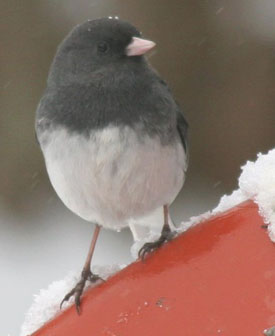White-breasted Nuthatch – Sitta carolinensis
General:
White-breasted Nuthatch is an agile bird that can typically be seen walking along a tree and even hanging upside down below a tree branch as it searches for insects and seeds.

White-breasted Nuthatches are common around bird feeders often taking seeds, nuts or pecking at suet. In winter, White-breasted Nuthatches join mixed flocks with chickadees and tufted titmice.
White-breasted Nuthatches typically build nests in natural tree cavities or abandoned woodpecker holes. The eggs are about .7″ long are white with light red-brown speckles. The chicks hatch in approximately 13 – 14 days and fledge in about another 14 days.
Identification:
The largest North American nuthatch, the White-breasted Nuthatch has a large head, short tail The White-breasted Nuthatch – Sitta carolinensis and short wings. They are a sparrow sized bird, approximately 5″ – 6″ long. The upperparts of the White-breasted Nuthatch are pale blue-gray, and the face and under-parts are white. It has a black cap and a white lower belly.
– 6″ long. The upperparts of the White-breasted Nuthatch are pale blue-gray, and the face and under-parts are white. It has a black cap and a white lower belly.
Habitat: White-breasted Nuthatches are birds of mature woods and woodland edges. They are more likely to be found in deciduous tree stands, including maple, hickory, basswood, and oak. However, they can also be found in coniferous forests.
Territory:
They are widely dispersed. White-breasted Nuthatches range from British Columbia to Nova Scotia to Florida and Mexico
Food:
The White-breasted Nuthatch forages along tree trunks and branches in a similar way to woodpeckers. White-breasted Nuthatches eat insects. They also eat seeds and nuts, including acorns, hawthorn, sunflower seeds. At birdfeeders they eat seeds, nuts and suet.
Credits:
Patuxent Bird Identification Info Center
The Audubon Society – Field Guide to North American Birds (Eastern Region)
Wikipedia, the free encyclopedia
Cornell Lab of Ornithology


 Iridescent green face patch sweeping through eye and tapering to the back of head. Chest is buff with dark spotting. The flanks are gray and back Vertical white line at fore part of flanks. Horizontal black line above flanks, buff outer under-tail coverts bordered by black. The central under-tail coverts are black.
Iridescent green face patch sweeping through eye and tapering to the back of head. Chest is buff with dark spotting. The flanks are gray and back Vertical white line at fore part of flanks. Horizontal black line above flanks, buff outer under-tail coverts bordered by black. The central under-tail coverts are black. her edges. It has a plain yellow face with yellow eye ring surrounding dark eye and yellowish legs. The adult male has golden yellow plumage with rusty streaks on breast and flanks. Female and immature yellow warblers have plain yellow plumage, their streaks on breast absent or barely noticeable.
her edges. It has a plain yellow face with yellow eye ring surrounding dark eye and yellowish legs. The adult male has golden yellow plumage with rusty streaks on breast and flanks. Female and immature yellow warblers have plain yellow plumage, their streaks on breast absent or barely noticeable. These birds feed on insects and spiders, but northern races will also take some berries. As they are visitors to my bird feeders and will take suet cake offerings.
These birds feed on insects and spiders, but northern races will also take some berries. As they are visitors to my bird feeders and will take suet cake offerings.


 is presumably due to their diet of seeds and when the food source is available. Because they breed late in the season they typically only raise one brood.
is presumably due to their diet of seeds and when the food source is available. Because they breed late in the season they typically only raise one brood.